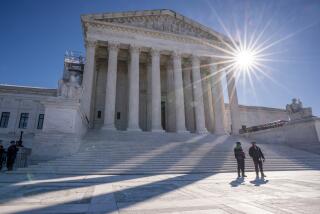Florida Airs Some Must-See TV
- Share via
It sure wasn’t Court TV.
If ever there was an argument for TV cameras in courts, however, it was Monday’s historic televised hearing before the Florida Supreme Court that may directly influence whether the next president will be a Republican or a Democrat.
Rarely has there been more legalspeak about federal codes and things pursuant to this and that, yet rarely anything more fascinating on the small screen in educating the public about a process cordoned off from the vast majority of Americans.
This amazing primer brought out judicial black robes and lawyerly spin galore in the most televised legal whoop-de-do from Florida since live coverage of the William Kennedy Smith trial in 1991--when the nephew of Sen. Edward M. Kennedy (D-Mass.) was acquitted in West Palm Beach of raping a 29-year-old woman who wore an electronic blue dot on TV to hide her identity from viewers.
No blue dots Monday.
No bloody glove, either. This was no criminal case, the kind that have so many people hyperventilating about TV cameras in courtrooms, especially since the televised murder trial of O.J. Simpson in the deaths of his former wife, Nicole Brown Simpson, and Ronald Goldman.
*
As if joined at the hip, the media black robes were out in force Monday as well, from ABC’s Peter Jennings, CBS’ Dan Rather and NBC’s Tom Brokaw to the cable minions of C-SPAN, CNN, Fox News Channel and MSNBC. In Los Angeles, KCAL and KTLA joined the major network stations in airing the hearing live.
And what did viewers observe in this distinctive Supreme Court universe? They got a jolt if they expected the conventional, expensive attorneys making eloquent, beautifully crafted arguments before the highest court in Florida. Instead, lawyers on both sides were repeatedly interrupted and aggressively peppered with questions from justices who must have thought they were Judge Judy or something.
It was like watching a bunch of guys defend their doctoral dissertations. Or like watching them try to get to a high-rise penthouse on an elevator that stopped on every floor. It was challenging, it was invigorating.
And thanks to Florida, where televising state Supreme Court hearings is routine, anyone in front of a set around midday got front-row seats for 2 1/2 hours of remarkable television. When it had ended, you ran it back in your mind, reviewing the footnotes that might foretell whether the court would give thumbs up to Vice President Al Gore or Texas Gov. George W. Bush.
As veteran court watchers will tell you, clue-watching can be misleading. For questions asked by justices are not necessarily an accurate map of where they are going.
Florida may have trouble getting it all together when it comes to presidential elections, but its policy on TV cameras in courtrooms is as enlightened as they come. Although cameras remain banned from federal courtrooms, Florida joins California and most other states in allowing them in state courts. In Florida’s case, that includes Supreme Court proceedings too. Bravo!
Live cameras have been a fixture in California courtrooms since 1980 and were flies on the wall of the first trial of the Los Angeles police officers who clobbered Rodney G. King. They’ve gotten a bum rap here more recently, however, thanks mostly to the first of two Simpson trials, where Court TV’s pool coverage was somehow blamed for the teeming masses of bad actors and wretched sideshows--otherwise known as media--operating outside the courtroom. Because of that, cameras were excluded from Simpson’s subsequent civil trial.
*
Potentially at odds here are 1st Amendment press freedoms and a defendant’s right to a fair and speedy trial. That conflict has pre-TV roots, at least as far back as Bruno Richard Hauptmann’s 1935 conviction in the kidnapping and murder of Charles Lindbergh’s young son following a rowdy trial, during which news-reelers were let inside and newspapers ran banner headlines judging him to be guilty before the jury did.
As people are noting a lot these days vis-a-vis the lingering presidential vote count, democracy is messy.
How does this intersect with TV cameras monitoring the Florida Supreme Court? Whether observing that body or other legal proceedings, cameras are essential for providing a complete record, aside from still photos and the subjectivity of courtroom artists, sound bites, print accounts and transcripts. The latter express words, not tone, emphasis or body language, each of which can deliver a message apart from the written text. As viewers saw Monday.
Only someone who has seen a legal proceeding from start to finish is in a position to judge its outcome. Piecemeal just doesn’t work.
The major argument against cameras is that they alter normalcy, that they transform participants--judges, lawyers and witnesses--into actors, and that they potentially intimidate jurors. As if courtrooms, even without cameras, weren’t theater in which nearly everyone is putting on a show for everyone else. Moreover, the cameras are now small and unobtrusive.
Was there show-boating for the lens Monday? Who’s to know? But enlightening and entertaining it was, a landmark election yielding landmark television--regardless of who becomes president.
More to Read
The complete guide to home viewing
Get Screen Gab for everything about the TV shows and streaming movies everyone’s talking about.
You may occasionally receive promotional content from the Los Angeles Times.






